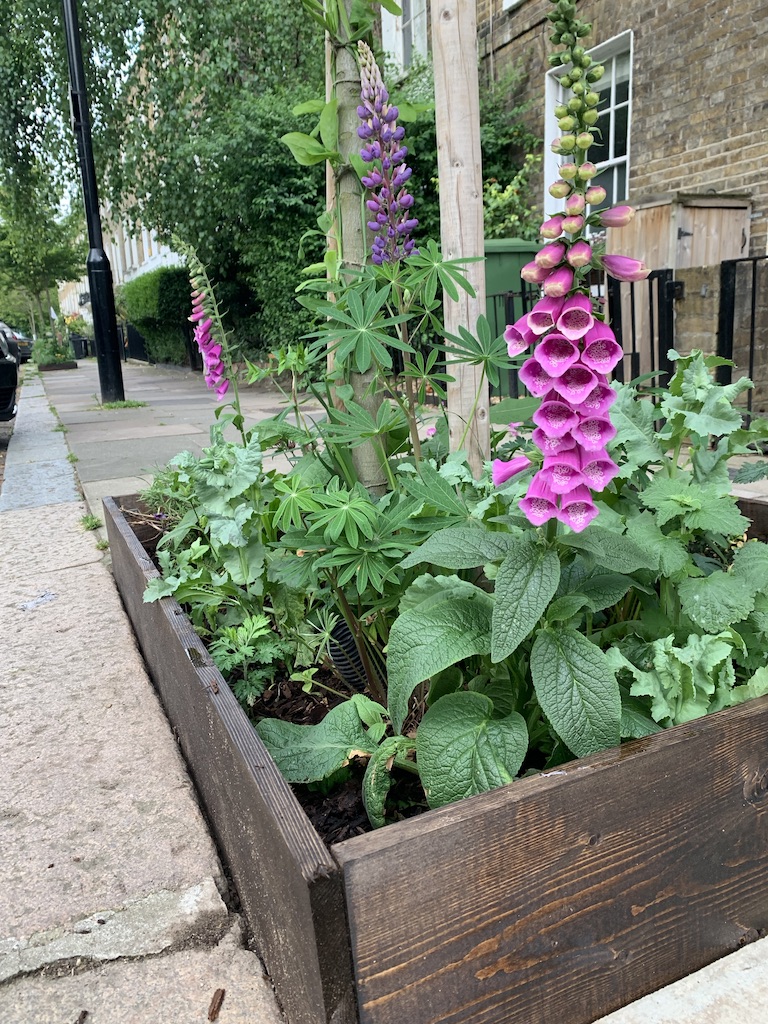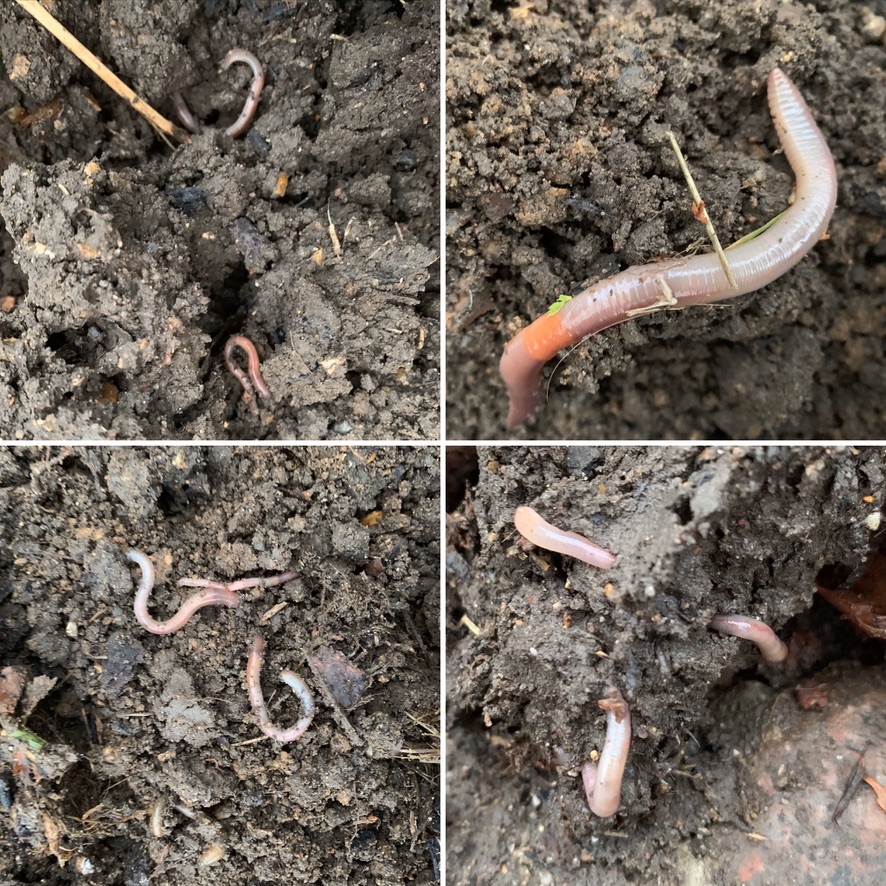You’re keen to turn the dustbowl around the tree outside your front door into a wildlife oasis.
You’ve checked that you have the long-term commitment with 3 QUESTIONS TO ASK YOURSELF BEFORE GUERRILLA GARDENING A TREE PIT and you also consider the wellbeing of the tree above the pit paramount so you will follow the 3 DOS AND DON’TS WHILE GUERRILLA GARDENING THE A TREE PIT.
Step one – create a border
You can nurture a guerrilla garden in a tree pit without a border. But passersby – children on scooters, adults with shopping trolleys – will continually be bashing into the plants or walking on it, particularly the pedestrian side. So a border of some kind is a good idea.

But check the regulations of your local authority before you build anything.
Our inspiration, Liz, for the height and shape of the edging came the photo of a tree pit nearby in a Tweet by Camden Council. It reminded people to tie green ribbons round trees they guerrilla garden to alert subcontractors who might be working on weed clerance or tree husbandry. So we set to.

We buy wood, paid for by the neighbours, cut to size by the wood merchant and stain it ourselves. We then dig out a little trench and fix the corners with L-shaped, metal brackets.

It takes a lot longer than you imagine but the edging protects the tree pit from the passersby and encourages the dogs and litter to go elsewhere. It also creates a micro-climate for the plants, reducing the wind which dries out the soil, stopping the water from running out on to the street and even shading the soil a little.
Step two – feed the soil
Now you have the borders, you can start enriching the soil to benefit the guerrilla garden and, of course, the tree. Whatever you do, do not cover the base of the trunk also known as the root flare (see here).

Think about how your might do so without buying stuff in plastic bags or delivered in big lorries. I go to the local city farm and carry home plastic bags of rotted manure in my shopping trolley, donating £2 per bag. I use leaf fall in the autumn, scooping it up in gloves from nearby gutters.
Your aim is zero-waste.
You’re also trying to feed the soil here rather than the plants, creating a layer under which the worms and funghi will thrive, shaded from the sun and thriving on the moisture. They will do the work of creating a fantastic growing environment for the plants and breaking up that beaten soil so much better than any human.

Step three – choose your plants
In the meantime, spend some time walking the streets of your city.
What plants already grow in guerilla gardens and particularly tree pits. You want to find tree pits that have been planted and then ignored, noticing what plants have survived such neglect. This is the plant palette from which you will develop your own.
They might not have the colour or the shape you desired but rewilding the city is finding out the plants that want to grow in your tree pit rather than buying expensive but unsuitable plants from nurseries, using water to keep them alive and probably not attracting polinators.

So, forage the plants. I knock on the doors of people close to the tree pit and ask whether I can did up a root of something in theirs. People are delighted to be asked and even happier to say yes. Or take a shoot of something you’ve seen and nurse it to a size to be planted out.
Or grow it from seed. Experiment with what annuals grow with zero waste by avoiding trays of plants from nurseries in plastic pots. Choose ones that encourage pollinators and re-seed year after year.

Then, water. Even a good summer thunder storm rarely reaches a tree pit. So water any new plant in. But, once it gets going, reduce water down to a minimum. If it looks unhappy, have you made the right choice?

And, finally…
Then, step back and enjoy. I reckon that every leaf that grows and every flower that opens in a tree pit is worth ten times the same achievement in a private garden. And work out which tree pit you will start guerilla gardening next. Remember rewilding the city is creating corridors for wildlife, partcularly pollinators. How might you connect yours to someone else’s?
Dear John,
I’m new to guerrilla gardening and have tried for the first time to grow plants around tree pits – ideal occupation during lockdown. It’s been a steep learning curve and I’m still trying to get my head around what to plant in the pits. If you have any tips or a list of hardy flowers to use, I would be hugely grateful.
Many thanks,
Justine
LikeLike
My first suggestion would be to take a look at what is growing in tree pits in your neighbourhood – particularly those that have been neglected. It will tell you what plants are likely to grow in your own. I often knock on doors near to a tree pit that has a plant that might work for me and ask if I can take a root when the time is suitable.
I’d also see what is growing in your friends’ gardens or neighbours’ front gardens – particularly those that are overgrown and neglected! Again, if the plants can survive those conditions they are more likely to survive in a tree pit. Ask your friends or knock on your neighbours’ doors.
So, for me, the list includes Geraniums, Euphorbias, perennial Helianthus, Persicaria, Lamium, Hellebores, hollyhocks, red Valerian, toadflax, cow parsley and, in very sunny ones, Calendula and cornflowers, both grown from seed and self-seeded.
What is crucial here is not that you try to grow what you like but rather what the tree pit is likely to support.
LikeLike
Dear John,
Thank you for your email and advice. It all makes a lot of sense and I’m slowly getting to grips with the varieties of flowers. I’m also looking at adding borders as you suggested in one of your posts to avoid vandalism and dog poos, as this has been an ongoing problem in our street. I was hoping to have large blooming pits by this summer but I’ve come to realise it will take time and patience is key.
It’s inspiring to see what you’ve been able to achieve and it gives me hope for our tree pits.
Thanks again and I look forward to reading your posts on instagram.
With kind regards,
Justine
LikeLike
Hi Justine
A tree pit is such a tough environment. It’s taken several efforts each year to get a guerrilla garden going in some of them. In fact, I have some tree pits where I have had a garden for only a couple of months the first year before everything appeared to shrivel only for a few plants to return the following year. Then the garden might last four months the following year…before shrivelling.
But, as I always say, a single flower or leaf in a guerrilla garden in a tree pit is worth ten in a private garden!
LikeLike